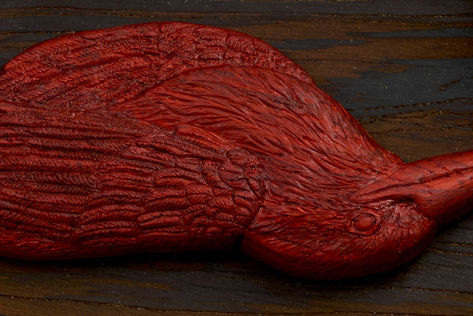Create Your First Project
Start adding your projects to your portfolio. Click on "Manage Projects" to get started
Sssilent nests
Medium
Maple wood, padauk wood, wenge wood, 23.75ct Yellow Gold Leaf, brass
The brown tree snake, originally native to parts of Australia, Papua New Guinea, and the Solomon Islands, is believed to have been accidentally introduced to Guam in the late 1940s or early 1950s. This likely occurred through military cargo shipments following World War II, during a time when U.S. military activity in the Pacific significantly increased. Guam, a U.S. territory in the Western Pacific, had no native snake species, and its ecosystem was entirely unprepared for a predator like the brown tree snake.
With an abundance of prey, no natural predators, and a tropical climate similar to its native environment, the snake rapidly spread across the island. Its excellent climbing ability allowed it to easily reach bird nests in trees, and its nocturnal, stealthy hunting habits made it particularly effective. As a result, the brown tree snake decimated Guam’s native bird populations, leading to the extinction of 10 out of 12 native bird species. The birds, many of which nested in trees or on the ground, had evolved without the threat of snake predation and were defenceless. The ecological impact was profound—pollination, seed dispersal, and other key ecosystem functions were disrupted. The brown tree snake’s invasion remains one of the most devastating examples of ecological collapse caused by an invasive species.
One of the affected bird species is the Guam kingfisher, a forest-dwelling, cavity-nesting bird once common across the island. The species suffered a steep decline, and by the 1980s, all wild populations had vanished. Conservationists launched a captive breeding program to save the species from extinction using the last remaining individuals. Today, the Guam kingfisher survives only in captivity. Efforts are underway to reintroduce it to predator-free islands and protected habitats, with the ultimate goal of one day restoring it to its native range.
---
A brown tree snake encircles a lifeless Guam kingfisher, its body shows ten distinct bulges, each marking a species it has made extinct on the island of Guam, including the Guam kingfisher. The snake acts as both frame and executioner, symbolising the invasive impact and silent extinction.
The snake is eating itself while referencing an ouroboros, which symbolises the cycle of life, death, rebirth, and nature's infinite loop. In this instance, this concept is proven not to work. This only works when things are balanced and natural, which is how nature operates. This balance shifts when something foreign is introduced, as seen with the foreign snake species that nearly drove all Guam island birds to extinction. Everything has consequences; unfortunately, it is destroying the island’s biodiversity and ecosystem.
The snake is covered in gold foil, just like a traditional gold frame would be around a painting. In this instance, the act, the dead kingfisher, is framed by the killer, the snake. Gold frames were used as they reflect light and draw attention, making artwork appear more luminous and important. It creates a striking contrast between the frame and the painting, helping to focus the viewer’s eye, which is exactly what I wish to achieve with this piece: to draw the viewers' attention to it, to see the ‘issue’. Besides their visual role, frames, gold or not, protect the edges of a painting from damage and separate it from the surrounding environment. Ironically, here the snake is what did the damage to the subject.
The background is dark, as I wanted there to be a very strong contrast with the gold frame and the orange kingfisher, highlighting it while also alluding to its sombre death.









